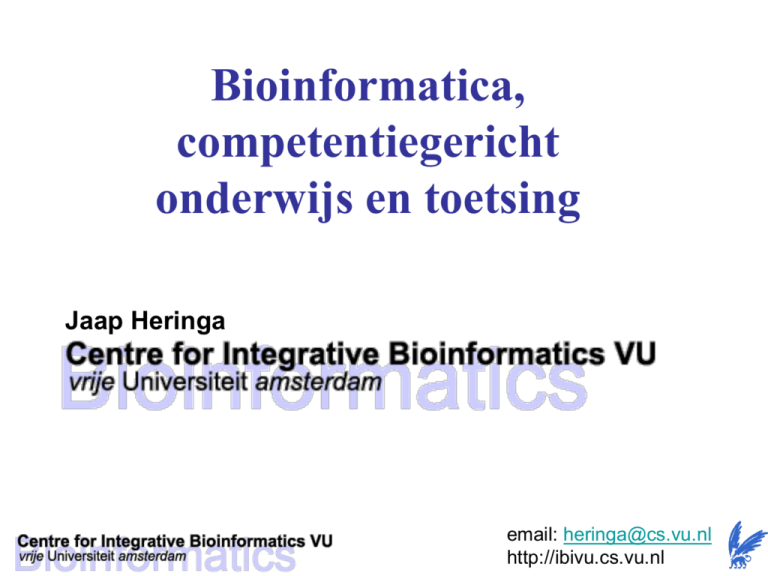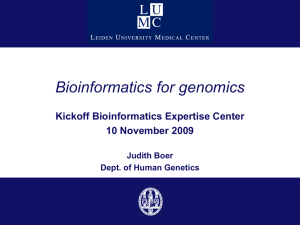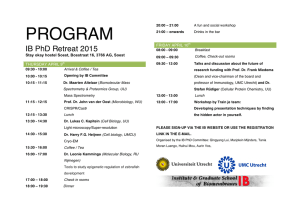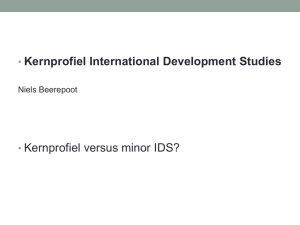Bioinformatics
advertisement

Bioinformatica,
competentiegericht
onderwijs en toetsing
Jaap Heringa
email: heringa@cs.vu.nl
http://ibivu.cs.vu.nl
This talk
• What is Bioinformatics and what is special
about it?
• Why is it currently seen as so important?
• What is the picture for students?
• How can we use all this in competencebased teaching and testing?
• What Bioinformatics training do we do at
the VU?
This talk
• What is Bioinformatics and what is special
about it?
• Why is it currently seen as so important?
• What is the picture for students?
• How can we use all this in competencebased teaching and testing?
• What Bioinformatics training do we do at
the VU?
Gathering knowledge
• Anatomy, architecture
Rembrandt,
1632
• Dynamics, mechanics
Newton,
1726
• Informatics
(Cybernetics – Wiener, 1948)
(Cybernetics has been defined as the science of control in machines
and animals, and hence it applies to technological, animal and
environmental systems)
• Genomics, bioinformatics
“The science of this century”
Bioinformatics
Chemistry
Biology
Molecular
biology
Mathematics
Statistics
Bioinformatics
Computer
Science
Informatics
Medicine
Physics
Bioinformatics
“Studying informational processes in biological
systems” (Hogeweg, early 1970s)
• No computers necessary
• Back of envelope OK
“Information technology
applied to the management and
analysis of biological data”
(Attwood and Parry-Smith)
Applying algorithms with mathematical formalisms in
biology (genomics); setting up computers
Bioinformatics in the olden days
• Close to Molecular Biology:
– (Statistical) analysis of protein and
nucleotide structure
– Protein folding problem
– Protein-protein and protein-nucleotide
interaction
• Many essential methods were created
early on:
– Protein sequence analysis (pairwise and
multiple alignment)
– Protein structure prediction (secondary,
tertiary structure)
Bioinformatics in the olden days
(Cont.)
• Molecular evolution was studied and
methods created
– Phylogenetic reconstruction (clustering – NJ
method
This talk
• What is Bioinformatics and what is special
about it?
• Why is it currently seen as so important?
• What is the picture for students?
• How can we use all this in competencebased teaching and testing?
• What Bioinformatics training do we do at the
VU?
But then the big bang….
The Human Genome -- 26 June 2000
Dr. Craig Venter
Sir John Sulston
Celera Genomics
Shotgun method
Human Genome
Project
Human DNA
• There are about 3bn (3 109) nucleotides in the
nucleus of 3.5 trillion (3.5 1012 ) cells of a human
body – a total of ~1022 nucleotides!
• Many DNA regions code for proteins, and are called
genes (1 gene codes for 1 protein in principle)
• Human DNA contains ~26,000 expressed genes
• Deoxyribonucleic acid (DNA) comprises 4 different
types of nucleotides (bases): adenine (A), thiamine
(T), cytosine (C) and guanine (G).
Human DNA (Cont.)
• People are different, but the DNA of different
people only varies for 0.2% or less. So, only 2
letters in 1000 are expected to be different. Over
the whole genome, this means that about 5 million
letters would differ between individuals.
• The Human Genome has recently been announced
complete (in 2004): >99% has been sequenced
reliably.
• Compact information: 1 gram of DNA contains
the information provided by a billion CDs!
Genome size
Organism
X-174 virus
Epstein Bar Virus
Mycoplasma genitalium
Hemophilus Influenza
Yeast (S. Cerevisiae)
Human
Wheat
Lilium longiflorum
Salamander
Amoeba dubia
Number of base pairs
5,386
172,282
580,000
1.8 106
12.1 106
3.2 109
16 109
90 109
100 109
670 109
A gene codes for a protein
DNA
CCTGAGCCAACTATTGATGAA
transcription
mRNA
CCUGAGCCAACUAUUGAUGAA
translation
Protein
PEPTIDE
Humans have spliced genes…
Genome information has changed
bioinformatics
• More high-throughput (HTP) applications
(cluster computing, GRID, etc.)
• More automatic pipeline applications
• More user-friendly interfaces
• Greater emphasis on biostatistics
• Greater influence of computer science (machine
learning, software engineering, etc.)
• More integration of disciplines, databases
and techniques
Protein Sequence-StructureFunction
Sequence
Structure
Threading
Homology
searching
(BLAST)
Function
Ab initio
prediction
and folding
Ab initio
Function
prediction
from
structure
Luckily for bioinformatics…
• There are many annotated databases (i.e. DBs
with experimentally verified information)
• Comparative analysis: We can relate biological
macromolecules using evolution and then “steal”
annotation of “neighbouring” proteins or DNA in
the DB
• This works for sequence as well as structural
information
• Problem: how do we score the evolutionary
relationships; i.e. we need to develop a measure
to decide which molecules are (probably)
neighbours and which are not
Function
recognition by
homology
searching
(BLAST):
Query
sequence
Non-redundant
annotated sequence
database
DB seq 1
(annotation)
DB seq 2
(annotation)
DB seq 3
(annotation)
Alignment
Score (E-value)
DB seq N
(annotation)
PSI-BLAST output example
Fold recognition
by threading:
Non-redundant
Protein structure
DB
Fold 1
THREADER and
GenTHREADER
Fold 2
Query
sequence
Fold 3
Compatibility
scores
Fold N
Functional Genomics
Genome
Expressome
Proteome
TERTIARY STRUCTURE (fold)
TERTIARY STRUCTURE (fold)
Metabolome
Genomics data
• Sequence data, Expression data, Regulation
networks, Signalling cascades, Translation, etc.
• Proteomics, Metabolomics, Physiomics
• Databases
–
–
–
–
–
–
–
–
DNA, EST
Protein sequence (UniProt)
Protein structure (PDB)
Microarray data
Proteome
Metabolome
Protein-protein interactions (PPI)
Mass spectrometry/NMR/X-ray
Microarrays
Proteome
Metabolic
networks
Glycolysis
and
Gluconeogenesis
Kegg database (Japan)
Modern bioinformatics is closely
associated with genomics
• The aim is to solve the genomics information
problem and understand cellular processes and
disease
• Ultimately, this should lead to biological
understanding how all the parts fit (DNA, RNA,
proteins, metabolites) and how they interact
(gene regulation, gene expression, protein
interaction, metabolic pathways, protein
signalling, regulation, etc.)
Algorithms in bioinformatics
• String algorithms
• Dynamic programming
• Machine learning (Neural Netsworks, k-Nearest Neighbour,
Support Vector Machines, Genetic Algorithms, ..)
• Markov chain models
• hidden Markov models
• Markov Chain Monte Carlo (MCMC) algorithms
• Stochastic context free grammars
• EM algorithms
• Gibbs sampling
• Clustering, tree algorithms
• Text analysis
• Hybrid/combinatorial techniques and more…
Bioinformatics
• Offers an ever more essential input to
– Molecular Biology
– Pharmacology (drug design)
– Agriculture
– Biotechnology
– Clinical medicine
– Anthropology
– Forensic science
– Chemical industries (detergent industries,
etc.)
This talk
• What is Bioinformatics and what is special
about it?
• Why is it currently seen as so important?
• What is the picture for students?
• How can we use all this in competencebased teaching and testing?
• What Bioinformatics training do we do at
the VU?
Studentenevaluatie
“De docent is wel goed maar het is een
idioot vak”
2de jaars VU student(e) Medische
Natuurwetenschappen
Bioinformatica onderwijs
Uitdagingen:
• de omvang (breedte/diepte) van het vak
• snelle ontwikkelingen
• weinig uitgewerkt lesmateriaal
• studententoestroom in Master vanuit zeer
verschillende disciplines (biologie, medicijnen,
chemie, informatica, natuurkunde, etc.)
Het opzetten van bioinformatica-onderwijs is een
flinke uitdaging.
Hoe zit dit voor studenten
• Studenten kunnen moeite hebben met de
oplossingsgerichte en heuristische aanpak
die vaak nodig is in bioinformatica
onderzoek.
• Vaak is een bioinformatisch probleem illdefined, zijn er veel verschillende
aanpakken mogelijk, en is er geen gouden
standaard om de aanpak te testen.
Hoe zit dit voor studenten
• Van antwoord naar vraag terugredeneren
is vaak moeilijk voor jongerejaars
studenten
Bioinformatics practioners
• Need to have a well-developed concept of the
art of doing science
• Need a high ability for (mathematical)
abstraction
• Need a broad developed knowledge
• Need an ability to quickly absorb and integrate
novel concepts
• Need well-developed engineering and practical
skills in the area of computer science.
Bioinformatics students
• Should have knowledge concerning all
neighbouring disciplines
• Should have an ability to deal with incomplete
knowledge and mental pictures, while still being
able to ask appropriate (research) questions
• Biology is the science area of complexity and
inconsistency, where mathematical and physical
concepts seem to derail frequently. Students
should be trained to deal with these
complexities.
Bioinformatica studenten
• Moeten met inconsistenties en complexiteit om
kunnen gaan.
• Moeten kennis hebben van o.a. biologie,
genomics, statistiek, modelleringstechnieken en
-formalismen, en multivariate statistiek.
• Moeten bioinformatica methoden kunnen
gebruiken en begrijpen.
• Moeten bioinformatica methoden kunnen
ontwikkelen (en kunnen programmeren)
Bioinformatica studenten
Sydney Brenner: “Bioinformatics research ranges
from book-keeping to real art”.
Students need to develop the skills and mentality
to allow this full range of activities.
This talk
• What is Bioinformatics and what is special
about it?
• Why is it currently seen as so important?
• What is the picture for students?
• How can we use all this in competencebased teaching and testing?
• What Bioinformatics training do we do at
the VU?
Competentiegerichte vraagstelling
(voorbeeld 1)
B.2. Een moleculaire biologe heeft een reguliere expressie waarmee zij de
functionaliteit van een eiwit kan vaststellen:
[AS]-D-[IVL]-G-x4-{PG}-C-[DE]-R-[FY]2-Q,
waarbij [XY] betekent dat X en Y voor kunnen komen op de positie, x4 betekent
ieder aminozuur voor 4 posities, en {PG} = not (P or G).
Ook heeft zij een multiple alignment van 30 orthologe sequenties met 150
posities waarin gaps voorkomen.
Zij wil graag weten of de sequenties in haar multiple alignment de functie
hebben zoals beschreven in de reguliere expressie, d.w.z. of de sequenties
voldoen aan het functionele motief zoals gegeven in de bovenstaande
reguliere expressie.
Competentiegerichte vraagstelling
(voorbeeld 1)
Vraag: geef een procedure met een scoring function
waarop zij dat zou kunnen doen. Bedenk dat het
functionele motief op meerdere posities in het multiple
alignment zou kunnen passen. Gebruik voor de scoring
functie de index x voor de positie in de reguliere
expressie (1 x 15), i voor de sequenties in het
alignment (1 i 30) en j voor de posities in het
multiple alignment (1 j 150). Hint: de procedure en
score moeten de best mogelijke fit weergeven.
Competentiegerichte vraagstelling
(voorbeeld 2)
B4. De biologe van vraag B.2. en B.3. heeft nog een multiple alignment
waarvoor zij graag de secundaire structuur zou willen bepalen.
Onderstaand zijn twee segmenten van het multiple alignment: voorspel
hiervoor de secundaire structuur.
De fragmenten van het multiple alignment zijn:
DKRSVLMICKTG
DRRTGLMIIRTG
EKRDILVILDTG
EKKDILMLIRTS
DKKEVIMILDTS
en
MVDRLIKEFYTSDNQ
MIDRLLREFYTTDDQ
MIERLLRDYYSTNDQ
VIDKILRDFFGSNNN
PAAKIIDDAFGSDEE
Neem als hydrofiele aminozuren: D, E, G, H, K, N, Q, R, S, en T.
Neem als hydrofobe aminozuren: A, C, F, I, L, M, P, V, W, en Y.
Hieronder staan de periodicity patterns zoals verwacht voor de -helix
en twee soorten -strand:
Competentiegerichte vraagstelling
(voorbeeld 2)
Periodicity patterns
Burried -strand
Edge -strand
-helix
hydrophobic
hydrophilic
Vraag: voorspel de secundaire structuur van de twee bovenstaande stukken
multiple alignment met gebruikmaking van de periodicity patterns. Gebruik de
letters ‘H’ voor helix, ‘B’ voor burried -strand, ‘E’ voor edge -strand, en ‘C’
voor coil.
Hint: Let op de conserveringspatronen in de multiple alignments.
This talk
• What is Bioinformatics and what is special
about it?
• Why is it currently seen as so important?
• What is the picture for students?
• How can we use all this in competencebased teaching and testing?
• What Bioinformatics training do we do at
the VU?
Bioinformatics teaching @ IBIVU
Introduction to Bioinformatics
26 two-hour course blocks
Medical Natural Sciences 2nd year
2-year international Bioinformatics master’s
International 2-year Master
Bioinformatics @ VU
Target group:
• Students with Bachelor Physics, Chemistry,
Mathematics, Computer Science, Biology, or Medical
Natural Sciences
• Students from Medicine or Health sciences?
• Computer science students don’t know the biology and
biology students don’t know the computer science
Remarks:
1. We require programming experience for some courses.
2. VU master teaching is moving towards pre-master of 6 months
maximally, to fill in deficiencies and to aim at students coming
from non-academic higher education.
International 2-year Master
Bioinformatics @ VU
Centre for Integrative Bioinformatics (IBIVU)
Faculty of Sciences/Faculty of Earth & Life Sciences
Free University Amsterdam
http://www.ibivu.cs.vu.nl
Outline: 45 ECTS courses, 75 ECTS practical
work (120 ECTS total):
•Compulsory courses 30 credits
•Optional courses 16-18 credits
•First traineeship 30-60 credits (Major)
•Second traineeship 15-30 credits (Minor)
•Optional third traineeship 15-30 credits
International 2-year Master
Bioinformatics @ VU
Compulsory courses (6 ECTS each):
Course 1. Sequence Analysis
Course 2. DNA/Protein structure-function analysis and prediction
Course 3. Bioinformatics data analysis and tools
Course 4. Genome analysis: structural and functional genomics
Course 5. Integrative bioinformatics
International 2-year Master
Bioinformatics @ VU
Compulsory courses (6 ECTS each):
• 2-hour lectures
•practical assignments (mini-projects)
•most assignments offer various complexity
options
•all information on-line (IBIVU website)
•students can get individual help from teachers
•students work on real open-ended research
questions, select approach themselves, and have
own responsibility
International 2-year Master
Bioinformatics @ VU
Optional courses (3-6 ECTS each):
Are provided by the IBIVU mainly through the Biology, Mathematics
and Computer Science Departments. Students may also choose courses
at other departments in consultation with your mentor.
A range of optional courses is available, including Introduction to
Bioinformatics, Statistical Genetics, Statistical Models, Machine
Learning, Evolutionary Methods, Neural Networks, Data Mining
Techniques, Scientific Visualization and Parallel Programming
(Department of Computer Science).
International 2-year Master
Bioinformatics @ VU
Traineeships:
•Can be carried out VU-wide:
•The Centre for Neurogenomics and Cognitive Research (CNCR)
•The Institute for Molecular Cell Biology (IMC)
•The IBIVU
•The Centre for Complex Molecules
•Embedded in national initiatives in which the IBIVU
participates:
•Ecogenomics
•Center for Medical Systems Biology (CMSB)
•Other national or international institutes (VU
Internationalisation)
Visualisation and Teaching
The ICwall @ VU
4096 x 1536
pixels
A cheap scalable solution: multiple beamers (from the back),
stereo viewing.
Challenges: alignment, porting software
Bioinformatics Masters in The
Netherlands
“Core” masters:
•CMBI, University of Nijmegen (Gert Vriend) –
classical, general
•Wageningen University (Peter Schaap), in
collaboration with CMBI – genomics oriented
•IBIVU, Free University of Amsterdam (Jaap
Heringa) – classical, general, tool creation
Bioinformatics Masters in The
Netherlands
“Combination” masters:
•Master Life Sciences, Groningen University (Ritsert
Jansen) – Bioinformatics courses
•Major Bioinformatics in Master Life Science &
Technology, University of Leiden (Joost Kok)
•Master Molecular Cell Biology and Bioinformatics,
University of Amsterdam, starting 2005
•Major Bioinformatics in Master Life Sciences, University
of Maastricht (Robert Vlietinck)
•Master Theoretical Biology & Bioinformatics, University of
Utrecht (Paulien Hogeweg) - modelling
•Master Genomics and Bioinformatics, University of
Utrecht (Albert Heck)
Netherlands BioInformatics Centre
(NBIC)
• Bioinformatics Application Service
Provider (BioASP)
• BioRANGE – National collaborative
bioinformatics integrated project
• Biowise – National bioinformatics training
initiative
– Biotune
• Software for categorising and storing teaching
materials
• Software for course development
name
aim
Sequence Analysis
A theoretical and practical bioinformatics course about biological sequence analysis. The
course provides an introduction to the algorithmic and biological principles of sequence
analysis, as well as practical implications.
Goals:
At the end of the course, the student will be aware of the major issues, methodology and
available algorithms in sequence analysis.
At the end of the course, the student will have hands-on experience in tackling biological
problems in sequence analysis.
contents
Theory:
Dynamic programming, database searching, pairwise and multiple alignment, probabilistic
methods, pattern matching, evolutionary models, and phylogeny.
Practical:
Assignment programming own alignment software based on dynamic programming
Assignment homology searching and pattern recognition using biological and disease
examples
Assignment multiple alignment of biological sequences
methodology
13 Lectures (2 two-hour lectures per week); Assignment introductions; Computer practicals;
Hands-on support
literature
E-course material: http://ibivu.cs.vu.nl
Books: Richard Durbin, Sean R Eddy, Anders Krogh, Graeme Mitchison (1998). Biological
Sequence Analysis. Cambridge University Press, 350 pp., ISBN 0521629713.
teaching
Active participation (November/December 2004).
test
target group
remarks
required knowledge
Assignment results and oral or written exam (depending on number of course students)
Students with Bachelor Physics, Chemistry, Mathematics, Computer Science, Biology, or
Medical Natural Sciences, with a strong interest in Bioinformatics
The course is taught in English
Some experience in programming is required.
name
DNA/Protein Structure-Function Analysis and Prediction
aim
A theoretical and practical bioinformatics course on the analysis and prediction of structurefunction relationships of DNA and protein molecules. The course provides an introduction to
the molecular principles of structure and function, available bioinformatics analysis and
prediction techniques, and biological databases.
Goals:
At the end of the course, students will be aware of the major issues, methodology and .
At the end of the course, the student will have hands-on experience in molecular modeling
and studying structure-function relationships.
contents
Theory:
Protein folding and energetics, experimental structure determination, protein fold families,
protein structure databases, protein secondary structure prediction, fold prediction, molecular
modeling, protein-protein interactions, DNA/RNA structure/function, DNA/RNA structure
prediction
Practical:
Assignment homology modelling
Assignment immunocomplex modelling
methodology
13 Lectures (2 two-hour lectures per week); Assignment introductions; Computer practicals;
Hands-on support
literature
E-course material: http://ibivu.cs.vu.nl
Books: Carl Branden & John Tooze (1998). Introduction to Protein Structure. 2nd Edition or
higher. Garland Science, 410 pp., ISBN 0815323050.
teaching
test
target group
remarks
required knowledge
Active participation (January/February 2005).
Assignment results and oral or written exam (depending on number of course students)
Students with Bachelor Physics, Chemistry, Mathematics, Computer Science, Biology,
Medical Natural Sciences or Medicine, with a strong interest and some basic knowledge in
Bioinformatics
The course is taught in English.
A completed course Sequence Analysis is a strong advantage.
Name
Bioinformatics data analysis and tools
aim
A theoretical and practical bioinformatics course on the fundamentals of bioinformatics tools
and tool creation for biological data mining.
Goals:
At the end of the course, students will be aware of the issues, methodology and available
bioinformatics tools for
At the end of the course, students will have hands-on experience in molecular modeling and
studying structure-function relationships.
contents
Theory:
Inverse protein folding, introduction to statistical thermodynamics of soft and biological
matter (5 lectures), genetic algorithm, repeat recognition tools and concepts (e.g.
transitivity), molecular mechanics simulations, (hidden) Markov models, pattern recognition,
machine learning techniques
Practical:
Assignment Statistical Thermodynamics
Assignment hidden Markov modelling
methodology
13 Lectures (2 two-hour lectures per week); Assignment introductions; Computer practicals;
Hands-on support
literature
E-course material (slides, assignment material, papers): http://ibivu.cs.vu.nl
Books: Biological Physics. Energy, Information, Life. Philip Nelson. 600 pages , W H
Freeman & Co., (July 2003), ISBN: 0716743728
teaching
Active participation (April/May 2005).
test
Assignment results and oral or written exam (depending on number of course students)
target group
Students with Bachelor degree in Physics, Chemistry, Mathematics, Computer Science,
Biology, Medical Natural Sciences or Medicine, with a strong interest and some basic
knowledge in Bioinformatics
remarks
required knowledge
The course is taught in English.
A completed course Sequence Analysis and DNA/Protein Structure-Function Analysis and
Prediction is a strong advantage. Some experience in programming is required.
name
aim
contents
methodology
Genome Analysis
A 1-month intensive course for introduction to genomics and bioinformatics techniques used to analyse and
integrate genomics data sets.
Static genome analyses: DNA, RNA and protein primary, secondary, tertiary en quaternary structures; genome
sequencing, methods and annotation; genome projects (bacteria, yeast, plant, animal, human), bioinformatics
and databases; COG, EST, SNP, motifs
Dynamic genome analyses: transcriptome (arrays en clustering, QPCR, SAGE); proteomics (mass spectrometry,
arrays, 2D gel electrophoresis, homology modeling); metabolomics (methods, interpretation, databases)
Functional genetics: knock-out, reporter genes, expression vectors, promoter-probe studies; reverse genetics,
RNAi, transgenese
Integrative genome analyses: network modelling, Metabolic Control Analysis, biochemical databases;
physiomics
Application areas: medical genomics; ecogenomics; sociogenomics; pharmacogenomics; biotechnological
genomics; ethical aspects
15 short modules, each including a lecture, (computer) practical and self study
Tutorials/discussions of book material, lecture notes
Computer practicals
Lab demonstrations: Students follow and assist an experienced postdoc/Ph D student performing a key
experiment. Data evaluation and interpretation on site.
literature
Powerpoint presentations via Blackboard
Book: A primer of genome science. Gibson G and Muse, SV, Sinauer Associates Inc Publishers, 2002, ISBN 087893-234-8 (pbk).
E-course material: http://ibivu.cs.vu.nl
teaching
Active participation
test
target group
remarks
required knowledge
Exam (50%), assignments (25%) and computer analyses (25%)
Students with Bachelor Physics, Chemistry, Mathematics, Computer Science, Biology, or Medical Natural
Sciences, with a strong interest in Bioinformatics
The course will be taught in Dutch; provisions can be made for English speakers.
Bachelor Physics, Chemistry, Mathematics, Computer Science, Biology, Medical Natural Sciences.
name
aim
contents
Integrative Bioinformatics - Intracellular networks
A 1-month intensive course providing an introduction to cell biological networks.
Theory:
The course gives an introduction to the behavior of intracellular networks, including metabolic pathways,
signal transduction chains, gene expression pathways and their hierarchical organization.
Metabolic and Hierarchical Control Analysis, Biological Non Equilibrium Thermodynamics, Genetic Network
Analysis, Elementary Mode Analysis, Flux (Balance Analysis) will be explained and practiced.
The levels of genomics (genome, transcriptome, proteome, metabolome and function) and their
interrelationships will be clarified, both theoretically and experimentally.
Practical:
inspection experiments performing flux and metabolite; measurements and subsequent regulation analysis;
inspection experiments; designing network targeted inhibitors of parasites; flux analysis on the basis of a set of
computer data; control analysis on the basis of earlier experimental results;
extra assignment integrative bioinformatics for bioinformatics master students (1 ECTS)
methodology
Lectures; Tutorials/discussions of book material; Lecture notes
Web-courses (www.siliconcell.net ); Computer practicals; Lab-inspection work: Students follow and assist an
experienced postdoc/Ph D student performing a key experiment. Data evaluation and interpretation on site.
literature
E-course material: http://www.bio.vu.nl/hwconf/teaching/Mathbiochemie/; www.siliconcell.net
Books: Chapters from:Understanding the Control of Metabolism (Fell, D) Portland Press; Metabolic
Engineering in the Postgenomic Era (Kohlodenko & Westerhoff, Editors), Horizon Bioscience;
Thermodynamics and Control of Biological Free-energy transduction (Westerhoff and Van Dam), Elsevier
teaching
Active participation (March/April 2005)
test
target group
remarks
Required knowledge
Written exam
Students with Bachelor Physics, Chemistry, Mathematics, Biology, Medical Biology with a strong interest in
the interface between these disciplines and bioinformatics
The course is taught in the English language and involves extensive direct contact with the professors and
associate professors.
Bachelor Physics, Chemistry, Mathematics, Informatics, Biology, Medical Natural Sciences, or equivalent;
Integrative Visualisation
Porting SARAgene virtual reality comparative
genomics software
The CAVE @ SARA
The ICwall @ VU
SaraGene
3D visualisation important for large genomic data sets:
• Clustering and mapping genes onto location,
expressome, metabolome, etc.
• Many data objects (labels): need 3D to place objects
and high resolution to read labels
• CAVE has good 3D but low resolution (e.g. labels
not easily readable)
• ICwall has bit less 3D capability but much higher
resolution.
Problems/suggestions
• Diverse target group, how to get students up to scratch
before starting masters. Lost a (biology) student due to
inability to program.
– Biosapiens pre-master?
– Biosapiens driven bioinformatics bachelor?
• Standards/exams
– Competence based learning: minimal skills/knowledge definition
– European bioinformatics master certificate
• Structuring subjects: students don’t always appreciate
where things fit in. “Teacher was OK but subject is idiotic”
• Lack of students in Dutch science faculties
– Biosapiens driven Bioinformatics PR initiative (e.g. Bioinformatics
and Society)
• Utilities
– Bioinformatics practical course book; slides, exercises, practical,
exam questions DB; E-learning; Grid-based distance learning,
Visualisation/ICwall
Needs
• Quality of teaching
– Train the trainers (Biosapiens can help)
• Course material organized (in english (!)
and accessible) (Biosapiens)
– Background material previous to the
master courses
• Standards and reciprocal recognition
• What else do we need?
Funding possibilities
• Erasmus mundus and European
initiatives
• BioSapiens training and general
courses (“European Permanent School
and Advanced workshops”)
• ESF, EMBO and FEBS possible liasons
for workshop organization
• Students interchange (housing facilities)
THE END
Abstract
•
•
•
De laatste jaren is in Nederland toenemend geïnvesteerd in onderzoek en onderwijs in de
Bioinformatica. Dit is in belangrijke mate het gevolg van ontwikkelingen in het genomics- en
biomedisch onderzoek, waarbij Bioinformatica steeds meer een centrale plaats inneemt.
Bioinformatica is een zeer breed en multi-disciplinair vak, waar informatici, statistici, biologen en
medici zeer nauw moeten samenwerken. Algoritme ontwikkeling (machine learning) en highthroughput data mining (grootschalige analyses van genomics datasets) is een essentiele
component van het bioinformatica onderzoek. Daarbij is het onderzoek toenemend toegepast en
grootschalig, veroorzaakt door de beloften die genomics onderzoek biedt en de reusachtige
datasets die door genomics onderzoekers worden gegenereerd. De breedte/diepte van het vak,
de snelle ontwikkelingen en het feit dat er nauwelijks uitgewerkt lesmateriaal is, maakt dat het
opzetten van bioinformatica-onderwijs een enorme uitdaging is.
Aan de Vrije Universiteit verzorgd het Centre for Integrative Bioinformatics masteronderwijs
alsmede een bachelorcursus Bioinformatica voor studenten Medische Natuurwetenschappen
(MNW). Onze ervaring is dat studenten moeite kunnen hebben met de oplossingsgerichte en
heuristische aanpak die vaak vereist is in bioinformatica onderzoek. Naast het aanleveren van
benodigde kennis (waar een selectieprobleem heerst door de breedte van het vak) staat
competentiegericht onderwijs centraal.
In mijn voordracht bespreek ik de centrale problemen en positionering van Bioinformaticaonderzoek en zal ik ingaan op de competentiegerichte elementen in onderwijs en toetsing.


